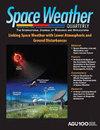Resolving Moving Heliospheric Structures Using Interplanetary Scintillation Observations With the Murchison Widefield Array
IF 3.8
2区 地球科学
Q2 ASTRONOMY & ASTROPHYSICS
Space Weather-The International Journal of Research and Applications
Pub Date : 2023-10-01
DOI:10.1029/2023sw003570
引用次数: 0
Abstract
Abstract We have conducted a blind search in 49 consecutive days of interplanetary scintillation observations made by the Murchison Widefield Array from mid‐2019, with overlapping daily observations approximately East and South‐East of the Sun at an elongation of ∼30° and a field of view of 30°. These observations detect an unprecedented density of sources. In spite of these observations being taken at sunspot minimum, this search has revealed several interesting transitory features characterized by elevated scintillation levels. One solar wind enhancement is captured in two observations several hours apart, allowing its radial movement away from the Sun to be measured. We present here a methodology for measuring the plane‐of‐sky velocity for the moving heliospheric structure. The plane‐of‐sky velocity was inferred as 0.66 ± 0.147 hr −1 , or 480 ± 106 kms −1 assuming a distance of 1AU. After cross‐referencing our observed structure with multiple catalogs of heliospheric events, we propose that the likely source of our observed structure is a stream‐interaction region originating from a low‐latitude coronal hole. This work demonstrates the power of widefield interplanetary scintillation observations to capture detailed features in the heliosphere which are otherwise unresolvable and go undetected.利用默奇森宽场阵列的行星际闪烁观测来解析移动的日球层结构
从2019年中期开始,我们对默奇森宽场阵列(Murchison Widefield Array)连续49天的行星际闪烁观测进行了盲搜,每天的观测重叠在太阳的东侧和东南侧,延伸约30°,视场为30°。这些观测发现了前所未有的辐射源密度。尽管这些观测是在太阳黑子最小的时候进行的,但这次搜索已经揭示了几个有趣的瞬变特征,其特征是闪烁水平升高。一次太阳风增强是在相隔几小时的两次观测中捕捉到的,从而可以测量其远离太阳的径向运动。我们在这里提出了一种测量运动日球层结构的天空平面速度的方法。假设距离为1AU,平面速度推断为0.66±0.147小时−1,或480±106公里−1。在将我们观测到的结构与多个日球层事件表交叉对照后,我们提出我们观测到的结构的可能来源是一个起源于低纬度日冕洞的流相互作用区。这项工作证明了宽视场行星际闪烁观测在捕捉日球层的详细特征方面的力量,否则这些特征是无法分辨和未被发现的。
本文章由计算机程序翻译,如有差异,请以英文原文为准。
求助全文
约1分钟内获得全文
求助全文
来源期刊
CiteScore
5.90
自引率
29.70%
发文量
166
审稿时长
>12 weeks
期刊介绍:
Space Weather: The International Journal of Research and Applications (SWE) is devoted to understanding and forecasting space weather. The scope of understanding and forecasting includes: origins, propagation and interactions of solar-produced processes within geospace; interactions in Earth’s space-atmosphere interface region produced by disturbances from above and below; influences of cosmic rays on humans, hardware, and signals; and comparisons of these types of interactions and influences with the atmospheres of neighboring planets and Earth’s moon. Manuscripts should emphasize impacts on technical systems including telecommunications, transportation, electric power, satellite navigation, avionics/spacecraft design and operations, human spaceflight, and other systems. Manuscripts that describe models or space environment climatology should clearly state how the results can be applied.

 求助内容:
求助内容: 应助结果提醒方式:
应助结果提醒方式:


